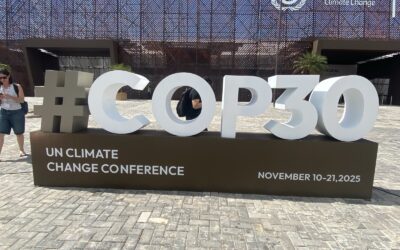Indigenous peoples, forest communities, and nature should be at the center of forest protection, not investors, groups say
April 24, 2025–Tropical forest countries, movements, Indigenous Peoples, local communities, and civil society should reject the proposed Tropical Forest Forever Facility (TFFF) as another misguided and false solution to climate change and biodiversity loss and instead prioritise transformative, human rights-based approaches that truly protect tropical forests, said the Global Forest Coalition (GFC) and Fundación Solón today.
The call comes on the release of a new report from GFC and Fundación Solón, TFFF: A False Solution for Tropical Forests, which critically examines the financial mechanism slated for launch at COP 30 in Belém, Brazil, warning that the world is set to repeat past mistakes and failures by prioritising profits over genuine ecological preservation.
The TFFF initiative was facilitated on the sidelines of the G20 summit in Indonesia in November 2022, where an agreement was announced among Brazil, Indonesia, and the Democratic Republic of the Congo (DRC), which combined are home to an estimated 52 percent of the world’s rainforests. Under the latest concept note released in February 2025, Brazil has established an Interim Steering Committee comprised of six tropical forest countries — Brazil, Colombia, the DRC, Ghana, Indonesia, and Malaysia — and six potential sponsoring countries, namely France, Germany, Norway, the United Arab Emirates, the United Kingdom, and the United States.
“The climate emergency is not a market failure but a failure of governance and responsibility. We need to confront the structural drivers of deforestation and invest in real solutions that empower local communities,” said Pablo Solón, Executive Director of Fundación Solón and co-author of the report. “Climate finance has long-since been co-opted by corporate interests, and the TFFF is no different — the alarm bells should be ringing for us all. The TFFF is a shiny new tool for greenwashing, designed to attract investment rather than tackle the systemic drivers of deforestation.”
The TFFF is positioned as a US$125 billion initiative aimed at compensating countries for maintaining their tropical forests, yet the report highlights significant flaws in its design. The mechanism, which proposes to pay just $4 per hectare annually, fails to address the systemic drivers of deforestation and commodifies vital ecosystems that are inextricably linked to the survival of Indigenous peoples, local communities, Afro-descendant peoples, and biodiversity. The report situates the TFFF within a wider context of market-driven “solutions” to the climate crisis, such as carbon offsets and REDD+ programs, which have repeatedly failed to deliver meaningful results.
“Forests are not commodities to be traded on financial markets,” said Mary Louise Malig, GFC Policy Director and co-author of the report. “They are living ecosystems with intrinsic value, crucial for the livelihoods of countless communities and the planet’s health. The TFFF reduces their worth to a mere dollar-per-hectare figure, which is not only wholly inadequate but fundamentally misguided.”
A Financial Model Built on Unstable Grounds
The TFFF operates on a frail financial model that relies on attracting US$125 billion in loans and investments, with the goal of generating $4 billion annually to distribute to tropical forest countries. However, the report cautions that the financial assumptions behind the TFFF are tenuous at best. If the fund fails to generate the projected returns of 7.5 percent, payments to countries could be reduced or halted altogether. The reliance on high-risk financial instruments to fund forest conservation is not only precarious but also fundamentally misaligned with the urgent need for stable, long-term solutions to combat deforestation and support the communities who rely on these ecosystems.
“The climate crisis is not a market failure; it is a systemic failure rooted in the exploitation of nature for profit. The TFFF feeds this same logic rather than challenging it,” said Malig. “Promising $4 per hectare for immense ecosystems while relying on unrealistically high investor returns is a recipe for disaster. When the fund falters, the consequences will fall on the forests and the communities that depend on them.”
Exclusion of Indigenous Peoples and Women: A Flawed and Inequitable Approach
One of the most contentious aspects of the TFFF is its payment structure. While the mechanism allocates 20 percent of the $4 per hectare payment to Indigenous Peoples and local communities, the remaining 80 percent is funnelled to national governments with no guarantees on how these funds will be utilised. This approach sidelines Indigenous Peoples, who manage 54 percent of the world’s remaining intact forests, and undermines their governance systems and traditional knowledge, which have been proven to be among the most effective in conserving forests.
“By sidelining Indigenous voices and decision-making power, particularly of women and girls, the TFFF perpetuates the very systems of governance that have historically oppressed these communities,” said Kwami Kpondzo, GFC’s Extractive Industries, Tourism and Infrastructure Campaign Coordinator. “Forest conservation mechanisms must take into consideration Indigenous traditional knowledge and prioritise the rights and needs of Indigenous Peoples, local communities, Afro-descendant peoples, women, and youth who manage over half of the world’s remaining intact forests.”
The exclusionary nature of the TFFF is further compounded by its failure to address the gendered dynamics of forest conservation. Women, particularly Indigenous women, are often the primary stewards of forests, playing vital roles in biodiversity protection, food systems, preservation of traditional knowledge, and sustainable livelihoods. Yet, the TFFF, as currently designed, fails to include meaningful gender-responsive policies, leaving women vulnerable to exclusion from financial benefits and decision-making processes. Any credible forest conservation effort must ensure that women’s rights, leadership, and knowledge are at the forefront of its approach.
“The climate crisis cannot be solved by mechanisms that perpetuate inequality,” added Satrio Manggala of GFC member organisation WALHI Indonesia. “We need solutions that give direct power to Indigenous Peoples and women, who are the true stewards of our forests, rather than sidelining them in favour of market-driven approaches.”
Recommendations for Genuine Action
In light of these findings, the report calls for a complete reevaluation of how financial mechanisms are structured to support tropical forests. Key recommendations include:
- Recognising Forests as Rights Holders: Treating forests as living entities with rights, rather than mere economic assets.
- Direct Funding to Indigenous Peoples: Allocating funding directly to Indigenous communities and local stakeholders who actively conserve the forests, instead of creating a forest financial mechanism that destroys their livelihood.
- Addressing the Root Causes of Deforestation: Implementing stringent regulations to combat industrial agriculture, mining, mega-projects infrastructure, and other destructive practices that lead to forest and biodiversity loss.
- Innovative Funding Models: Exploring alternative funding sources, such as reallocating military budgets or divesting fossil fuel extraction funds, to generate sustainable financing for forest conservation by LCs and IPs.
“The survival of tropical forests is not a negotiation among states; it is a matter of justice and survival for millions of people and species,” Solón concluded. “We must demand that our governments take bold action that reflects the urgent need for real change to protect life, rather than perpetuating false solutions that serve corporate interests.”
### ENDS ###
For more information or interview requests, please contact:
Megan Morrissey, GFC (USA) +1 2023656900 megan@globalforestcoalition.org
Jhoselyn Fernandez, Fundación Solón (Bolivia) +591 77267201
Satrio, WALHI (Indonesia) +62 811593600
Kwami Kpondzo, GFC +228 90 13 57 68
Note to Editors:
The following key facts and figures provide additional context about the Tropical Forest Finance Facility (TFFF) and relevant processes leading up to COP 30 in Belém, Brazil:
- What is the TFFF? The TFFF is a $125 billion financial mechanism proposed by Brazil to incentivise the preservation of tropical forests. It aims to pay $4 per hectare annually for standing tropical forests. The initiative is being presented as part of the “Baku to Belém Roadmap” under the New Collective Quantified Goal (NCQG) for climate finance, which seeks to mobilise $300 billion annually by 2035. Read more about the NCQG decision at COP 29.
- Key Players: The TFFF brings together major tropical forest countries, including Brazil, Indonesia, and the Democratic Republic of the Congo (DRC), which collectively account for 52 percent of the world’s tropical forests. An Interim Steering Committee was established in February 2025, comprising six tropical forest nations (Brazil, Colombia, DRC, Ghana, Indonesia, and Malaysia) and six potential sponsor countries (France, Germany, Norway, UAE, UK, and USA).
- How It Works: The TFFF proposes to raise $125 billion, primarily through loans and market investments, with the goal of generating $4 billion annually. Most of this funding would go to national governments, with 20 percent allocated to Indigenous Peoples and local communities. See the TFFF Concept Note (July 5, 2024).
- Concerns Raised:
- The $4 per hectare payment is seen as grossly inadequate, given the vast ecosystem services provided by tropical forests, such as carbon sequestration, water regulation, and biodiversity preservation.
- Payments would primarily go to national finance ministries, with no guarantees that funds will reach those directly protecting forests.
- The mechanism relies on untested financial assumptions, including achieving a 7.5 percent return on investments, and allows for reductions or suspensions in payments during financial downturns.
- Processes and Meetings:
- The TFFF concept was announced during the G20 Summit in Bali, Indonesia, in November 2022, and later unveiled at COP 28 in Dubai.
- COP 30, to be held in Belém, Brazil (November 2025), is expected to serve as the official launchpad for the mechanism.
- Deforestation Statistics: Tropical forests continue to disappear at a rate of 3.5 million hectares annually, underscoring the urgency for effective, equitable solutions.
Source: FAO Global Forest Resources Assessment 2020.




